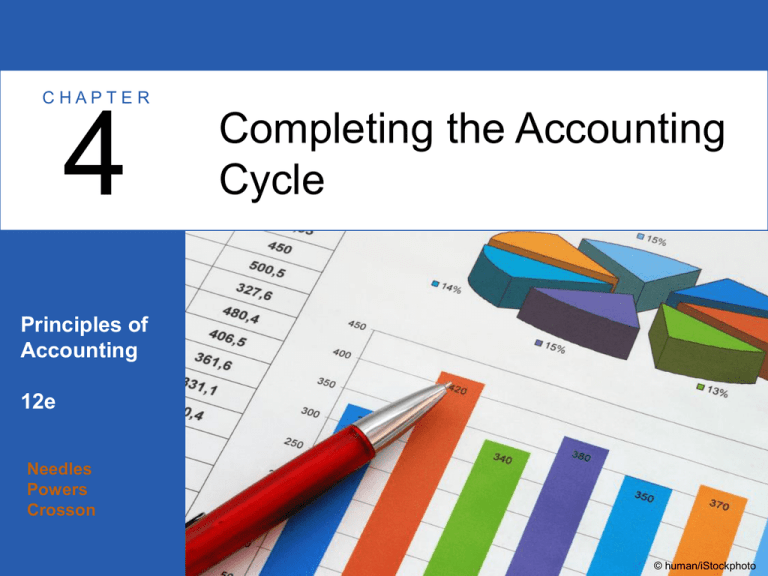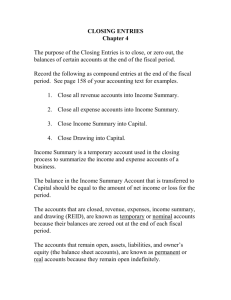
CHAPTER
4
Completing the Accounting
Cycle
Principles of
Accounting
12e
Needles
Powers
Crosson
© human/iStockphoto
Concepts Underlying Closing Entries
Closing entries are journal entries at the end of
the accounting period. They have two purposes:
– Setting the stage for the next accounting period
Closing entries clear revenue, expense, and withdrawals
accounts of their balances so that they can start over with a
zero balance in the next accounting period.
– Summarizing a period’s revenues and expenses
The Income Summary account is a temporary account that
summarizes all revenues and expenses for the period. It is
used only in the closing process, and its balance equals the net
income or loss.
The net income or loss is transferred from the Income Summary
account to the owner’s Capital account.
©2014 Cengage Learning. All Rights Reserved. May not be scanned, copied or duplicated, or posted to a publicly accessible website, in whole or in part.
Concepts Underlying Closing Entries
Closing entries help achieve periodicity by dividing the life
of the business into equal time periods.
To accomplish the closing process, it is important to
understand the concepts of permanent and temporary
accounts.
– Balance sheet accounts are considered permanent accounts (or
real accounts) because they carry their end-of-period balances into
the next accounting period.
– Revenue and expense accounts are considered temporary
accounts (or nominal accounts) because they are cleared by means
of the closing entries.
©2014 Cengage Learning. All Rights Reserved. May not be scanned, copied or duplicated, or posted to a publicly accessible website, in whole or in part.
Preparing Closing Entries
The steps involved in making closing entries are:
– 1. Close the credit balances on the income statement accounts to
the Income Summary account.
– 2. Close the debit balances on the income statement accounts to
the Income Summary account.
– 3. Close the Income Summary account balance to the owner’s
Capital account.
– 4. Close the Withdrawals account balance to the owner’s Capital
account.
The adjusted trial balance provides all the data needed to
record the closing entries.
©2014 Cengage Learning. All Rights Reserved. May not be scanned, copied or duplicated, or posted to a publicly accessible website, in whole or in part.
The Accounts After Closing
After all closing entries have been posted, everything is ready for the next accounting period.
– The revenue, expense, and withdrawals accounts
(temporary accounts) have zero balances.
– The owner’s Capital account has been increased or
decreased to reflect net income or net loss and has
been decreased for withdrawals.
– The balance sheet accounts (permanent accounts) show
the correct balances, which are carried forward to the
next period, as shown in the post-closing trial balance.
©2014 Cengage Learning. All Rights Reserved. May not be scanned, copied or duplicated, or posted to a publicly accessible website, in whole or in part.
Reversing Entries: An Optional First Step
A reversing entry is an optional journal entry made on the
first day of an accounting period.
– It has the opposite effect of an adjusting entry made at the end of
the previous period: It debits the credits and credits the debits of
an earlier adjusting entry.
– The sole purpose of reversing entries is to simplify routine
bookkeeping procedures, and they apply only to certain adjusting
entries, such as accruals.
– As illustrated on the next slide, reversing entries solve the problem
of applying expenses and revenues to the correct accounting
period.
©2014 Cengage Learning. All Rights Reserved. May not be scanned, copied or duplicated, or posted to a publicly accessible website, in whole or in part.
Reversing Entry for Accrued Revenue
Reversing entries apply to any accrued expenses
or revenues.
An adjusting entry for Blue Design Studio’s
accrued revenue would require the reversing entry
below.
©2014 Cengage Learning. All Rights Reserved. May not be scanned, copied or duplicated, or posted to a publicly accessible website, in whole or in part.
The Work Sheet: An Accountant’s Tool
To organize data and important information,
accountants use working papers.
– They provide evidence of past work.
– They enable accountants to retrace their steps when
they need to verify information on the financial
statements.
A work sheet is a special kind of working paper.
– It serves as a preliminary step in preparing financial
statements and lessens the possibility of errors.
©2014 Cengage Learning. All Rights Reserved. May not be scanned, copied or duplicated, or posted to a publicly accessible website, in whole or in part.
Preparing the Work Sheet
(slide 1 of 2)
Step 1: Enter and total the account balances in the Trial
Balance columns.
Step 2: Enter and total the adjustments in the Adjustments
columns.
Step 3: Enter and total the adjusted account balances in
the Adjusted Trial Balance columns.
– The work sheet uses crossfooting, or adding or
subtracting a group of numbers horizontally.
– The Adjusted Trial Balance columns are then footed
(totaled) to check the accuracy of the crossfooting.
©2014 Cengage Learning. All Rights Reserved. May not be scanned, copied or duplicated, or posted to a publicly accessible website, in whole or in part.
Preparing the Work Sheet
(slide 2 of 2)
Step 4: Extend the account balances from the
Adjusted Trial Balance columns to the Income
Statement or Balance Sheet columns.
Step 5: Total the Income Statement columns and
the Balance Sheet columns. Enter the net income or
loss in both pairs of columns as a balancing figure,
and recompute the column totals.
©2014 Cengage Learning. All Rights Reserved. May not be scanned, copied or duplicated, or posted to a publicly accessible website, in whole or in part.
Closing Entries and the Financial Statements
Closing entries set the accounts on the income
statement to zero and transfer the resulting
balance of net income or loss to the owner’s
Capital account on the balance sheet.
Closing entries do not affect cash flows.
©2014 Cengage Learning. All Rights Reserved. May not be scanned, copied or duplicated, or posted to a publicly accessible website, in whole or in part.
The Importance of the Work Sheet and
Closing Entries for Managers
Accountants use the completed work sheet in performing
three principal tasks:
– Recording the adjusting entries in the general journal.
The information needed to record the adjusting entries can be
copied from the work sheet.
– Recording the closing entries in the general journal.
The Income Statement columns of the work sheet show all the
accounts that need to be closed, except for the Withdrawals
account.
– Preparing the financial statements.
Once the work sheet has been completed, preparing the
financial statements is easy because the account balances have
been sorted into Income Statement and Balance Sheet columns.
©2014 Cengage Learning. All Rights Reserved. May not be scanned, copied or duplicated, or posted to a publicly accessible website, in whole or in part.
The Importance of the Work Sheet and
Closing Entries for Managers
Closing entries are important to managing a
business for the following reasons:
– The owners of the business expect periodic reports of
the progress of the business.
– In planning a business’s future operations, management
needs to prepare budgets for future time periods.
– For management to evaluate a company’s progress in
achieving its profitability goals, it is necessary to divide
the life of the business into relatively short time periods.
©2014 Cengage Learning. All Rights Reserved. May not be scanned, copied or duplicated, or posted to a publicly accessible website, in whole or in part.





